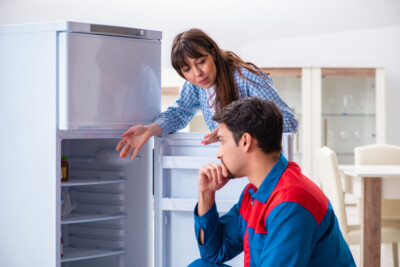My Refrigerator Is Only Freezing Not Cooling?
If your freezer is cold, but your cooler is hot, and your evaporator coils are frozen, you might have a problem with your defrost system. If the freezer in your fridge is cold, but the refrigerator is warm, your air-damper controls might be stuck shut or broken. If the refrigerator freezer is cold but the refrigerator is warm, there is a chance the parts cooling the fridge and freezer are not working correctly.
If a condenser fan is not working, then both the refrigerator and the freezer are not cooling correctly. If the condenser fan motor is not working, you might get a cooler freezer, but not any cooling at all in the freezer. If your fridge is not cooling well, it could have an issue with the condenser fan motor. If the condenser fan is not working correctly, your fridges temperature could go up, and your compressor could get too hot.
Without a functioning fan, it is easy for your fridge to get too hot and stop cooling. When the fan is not working correctly, it might look like you have got your freezer working just fine, but the fridge looks hot. If the smaller fan and motor are malfunctioning, the freezer or fridge may feel a lot warmer than normal. If ice builds up in any part of the system, your freezer should still function normally, but the fridge will be warmer.
If your evaporator fan is out, your freezer will get cold, but your fridge might be warmer. If the fan motor in your evaporator is malfunctioning or broken, that could be another reason the freezer is cold, but the refrigerator is not. The evaporator fan moves air over the evaporator coil, cooling it, then pushing air across the freezer and into your fridge. The evaporator takes the heat out of the freezer, cooling the contents, and turning cold refrigerant into hot vapor.
The cooled refrigerant flows through the expansion valve to the evaporator. Condensers combine the heat of the evaporator with that of compressed gas refrigerants, dissipating them to the air. Condenser coils convert refrigerant from vapor to liquid, releasing heat – the same heat you feel when it is blowing around your refrigerator during the cooling cycle. The job of the condenser fan is to keep both the compressor and the coils cool, so if the compressor breaks, your refrigerator starts heating up.
The air dam controls how much cool air is shared from the freezer into the refrigerator. When the air damper cannot open, no cold air is allowed to flow from the freezer into the refrigerator compartment, making it warmer. If the air damper cannot shut, or cannot open, then air cooling affects the fridges temperature, whereas the freezer stays at a proper temperature.
If the refrigerator believes that the door is always open, then it is not going to activate the condenser hard enough to keep it at the correct temperature. If broken, your thermostat cannot read temperatures accurately, telling your appliance exactly how cold the interior of your freezer is. If the fan in your freezer is still running, but the refrigerator is not getting any cooler, it may be that your compressor or compressor startup relay is broken. If you hear the compressor running, but the fridge is not getting cool, it is more than likely that either your evaporator coils are frozen, or the fan is jammed or broken.
Your refrigerator may also be losing cooling capacity, as it is literally losing the coolant liquid that creates cold. For whatever reason, however, your freezer is doing an excellent job of keeping things cool, whereas your refrigerator is not. Sometimes, you end up with the freezer that is still quite cool (because it is close to where the coils are) but the fresh produce compartment is nowhere near as cool (because there is no cooling air being forced in). One of the major problems with the refrigerator is when you discover the freezer is still cold, but other areas are hot.
It is a standard thing to find that most refrigerators use a fan to push the cold air from the freezer to an evaporator, which is then forced to the cooler areas, keeping them at a cooler temperature. Most fridges generate all of their cooling for the freezer, then the cooler area is kept cool by the ventilation vents between the fridge and freezer areas. Cold air cycles back and forth through an air vent.
Freezer-freeze accumulation also blocks a vent, diminishing or blocking the cold air that gets to a coolers compartment. If your freezer compartment is badly frosted, disconnect the fridge and open the freezer door to let the ice melt. If you take off the lid from the freezer and discover that the coils are fully filled with ice, take everything out of both freezer and refrigerator, unplug, and let thaw for 24-48 hours. If this happens, take the freezer and refrigerator apart, unplug the appliance, and allow the coils to thaw for one or two days.
If you leave your defrost heater off, frost will accumulate on your coils, and eventually, no air can get past the coils to deliver cooling to your freezer or fridge. A faulty thermostat will send no electricity to the refrigeration system, and therefore, the freezer will not get any cooling. If temperature controls accidentally go too high, the fridge may seem like it is not working. A bad door seal lets hot air through and lets cold air through, which is cold enough that the freezer will not get stuck.
The evaporator fan is responsible for pulling cold air out from a different set of coils and spreading it around the whole unit, first in the freezer, and then through the cooler (or fresh produce section).

